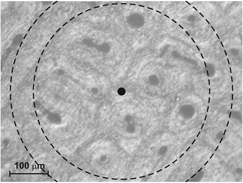Crossref Citations
This article has been cited by the following publications. This list is generated based on data provided by
Crossref.
Rodriguez-Florez, Naiara
Oyen, Michelle L.
and
Shefelbine, Sandra J.
2013.
Multi-Scale Permeability of Murine Bone Measured by Nanoindentation.
p.
1145.
Rodriguez-Florez, Naiara
Oyen, Michelle L.
and
Shefelbine, Sandra J.
2013.
Insight into differences in nanoindentation properties of bone.
Journal of the Mechanical Behavior of Biomedical Materials,
Vol. 18,
Issue. ,
p.
90.
Pereira, Andre F.
and
Shefelbine, Sandra S.
2013.
Modelling Rest-Inserted Loading in Bone Mechanotransduction Using Poroelastic Finite Element Models: The Impact of Permeability.
p.
1137.
Taffetani, M.
Gottardi, R.
Gastaldi, D.
Raiteri, R.
and
Vena, P.
2014.
Poroelastic response of articular cartilage by nanoindentation creep tests at different characteristic lengths.
Medical Engineering & Physics,
Vol. 36,
Issue. 7,
p.
850.
Pereira, Andre F.
and
Shefelbine, Sandra J.
2014.
The influence of load repetition in bone mechanotransduction using poroelastic finite-element models: the impact of permeability.
Biomechanics and Modeling in Mechanobiology,
Vol. 13,
Issue. 1,
p.
215.
Yao, Wang
Yoshida, Kyoko
Fernandez, Michael
Vink, Joy
Wapner, Ronald J.
Ananth, Cande V.
Oyen, Michelle L.
and
Myers, Kristin M.
2014.
Measuring the compressive viscoelastic mechanical properties of human cervical tissue using indentation.
Journal of the Mechanical Behavior of Biomedical Materials,
Vol. 34,
Issue. ,
p.
18.
Gao, Xin
and
Gu, Weiyong
2014.
A new constitutive model for hydration-dependent mechanical properties in biological soft tissues and hydrogels.
Journal of Biomechanics,
Vol. 47,
Issue. 12,
p.
3196.
Rodriguez-Florez, Naiara
Oyen, Michelle L.
and
Shefelbine, Sandra J.
2014.
Age-related changes in mouse bone permeability.
Journal of Biomechanics,
Vol. 47,
Issue. 5,
p.
1110.
Shapiro, Jenna M.
and
Oyen, Michelle L.
2014.
Viscoelastic analysis of single-component and composite PEG and alginate hydrogels.
Acta Mechanica Sinica,
Vol. 30,
Issue. 1,
p.
7.
Herbert, Erik G.
Sudharshan Phani, P.
and
Johanns, Kurt E.
2015.
Nanoindentation of viscoelastic solids: A critical assessment of experimental methods.
Current Opinion in Solid State and Materials Science,
Vol. 19,
Issue. 6,
p.
334.
Girolamo, Laura de
Niada, Stefania
Arrigoni, Elena
Giancamillo, Alessia Di
Domeneghini, Cinzia
Dadsetan, Mahrokh
Yaszemski, Michael J
Gastaldi, Dario
Vena, Pasquale
Taffetani, Matteo
Zerbi, Alberto
Sansone, Valerio
Peretti, Giuseppe M
and
Brini, Anna T
2015.
Repair of Osteochondral Defects in the Minipig Model by Opf Hydrogel Loaded with Adipose-Derived Mesenchymal Stem Cells.
Regenerative Medicine,
Vol. 10,
Issue. 2,
p.
135.
Rodriguez-Florez, Naiara
Garcia-Tunon, Esther
Mukadam, Quresh
Saiz, Eduardo
Oldknow, Karla J
Farquharson, Colin
Millán, José Luis
Boyde, Alan
and
Shefelbine, Sandra J
2015.
An Investigation of the Mineral in Ductile and Brittle Cortical Mouse Bone.
Journal of Bone and Mineral Research,
Vol. 30,
Issue. 5,
p.
786.
Oyen, Michelle L.
2015.
Nanoindentation of hydrated materials and tissues.
Current Opinion in Solid State and Materials Science,
Vol. 19,
Issue. 6,
p.
317.
Moshtagh, Parisa R.
Pouran, Behdad
Korthagen, Nicoline M.
Zadpoor, Amir A.
and
Weinans, Harrie
2016.
Guidelines for an optimized indentation protocol for measurement of cartilage stiffness: The effects of spatial variation and indentation parameters.
Journal of Biomechanics,
Vol. 49,
Issue. 14,
p.
3602.
Offeddu, G.S.
Ashworth, J.C.
Cameron, R.E.
and
Oyen, M.L.
2016.
Structural determinants of hydration, mechanics and fluid flow in freeze-dried collagen scaffolds.
Acta Biomaterialia,
Vol. 41,
Issue. ,
p.
193.
Bergholt, Mads S.
St-Pierre, Jean-Philippe
Offeddu, Giovanni S.
Parmar, Paresh A.
Albro, Michael B.
Puetzer, Jennifer L.
Oyen, Michelle L.
and
Stevens, Molly M.
2016.
Raman Spectroscopy Reveals New Insights into the Zonal Organization of Native and Tissue-Engineered Articular Cartilage.
ACS Central Science,
Vol. 2,
Issue. 12,
p.
885.
Armitage, Oliver E.
and
Oyen, Michelle L.
2017.
Indentation across interfaces between stiff and compliant tissues.
Acta Biomaterialia,
Vol. 56,
Issue. ,
p.
36.
Marchi, G.
Baier, V.
Alberton, P.
Foehr, P.
Burgkart, R.
Aszodi, A.
Clausen-Schaumann, H.
and
Roths, J.
2017.
Microindentation sensor system based on an optical fiber Bragg grating for the mechanical characterization of articular cartilage by stress-relaxation.
Sensors and Actuators B: Chemical,
Vol. 252,
Issue. ,
p.
440.
Le Pense, Solenn
and
Chen, Yuhang
2017.
Contribution of fluid in bone extravascular matrix to strain-rate dependent stiffening of bone tissue – A poroelastic study.
Journal of the Mechanical Behavior of Biomedical Materials,
Vol. 65,
Issue. ,
p.
90.
Fabris, Gloria
Lucantonio, Alessandro
Hampe, Nico
Noetzel, Erik
Hoffmann, Bernd
DeSimone, Antonio
and
Merkel, Rudolf
2018.
Nanoscale Topography and Poroelastic Properties of Model Tissue Breast Gland Basement Membranes.
Biophysical Journal,
Vol. 115,
Issue. 9,
p.
1770.



